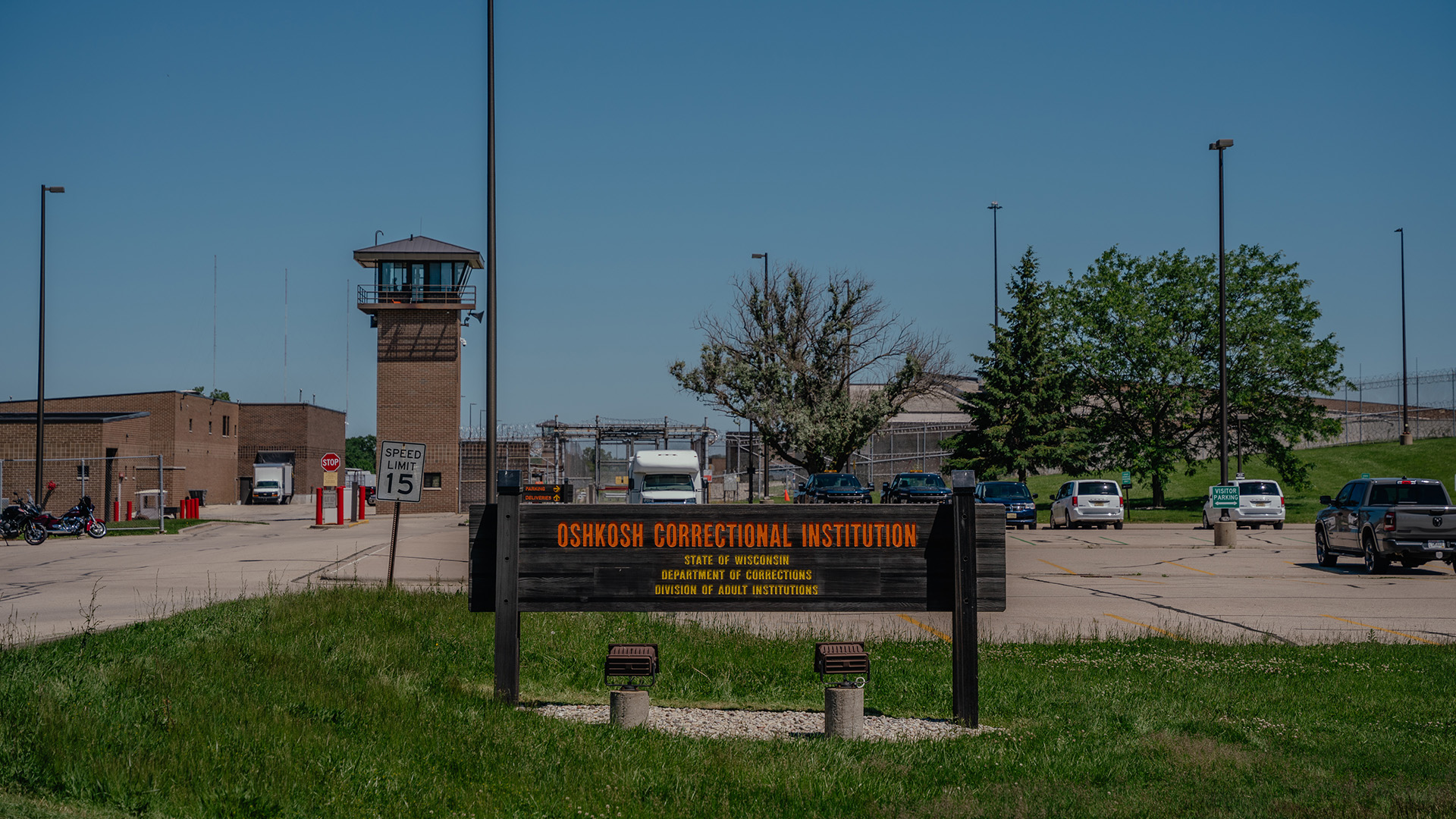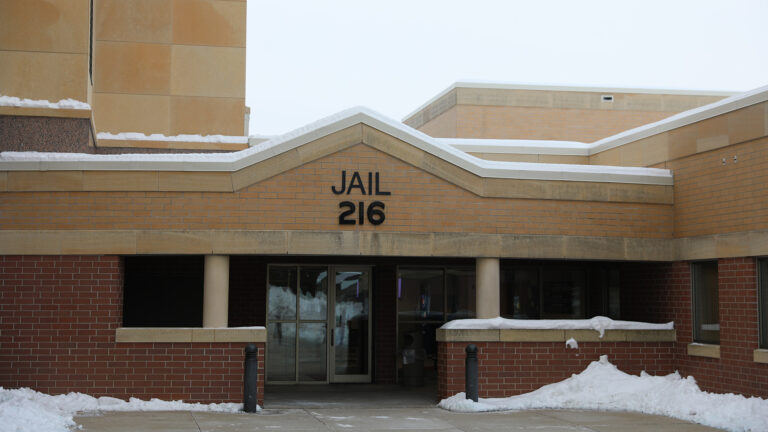Nearly one-third of doctors working in Wisconsin's prisons have been censured
The Wisconsin Department of Corrections is facing scrutiny for failing to care for people it incarcerates, and an investigation has found nearly a third of the 60 staff physicians the system has employed over the past decade have been censured by a state medical board for an error or a breach of ethics.
Wisconsin Watch
July 8, 2024

A sign sits outside the medium-security Stanley Correctional Institution on June 9, 2024, in Stanley. Nearly a third of the 60 staff physicians Wisconsin's corrections system has employed over the past decade have been censured by a state medical board for an error or a breach of ethics. (Credit: Jamie Kelter Davis for The New York Times)

This article was first published by The New York Times and Wisconsin Watch.
While serving time in a Wisconsin prison in 2021, Darnell Price watched a golf-ball-size lump on his thigh grow as large as a football. Price pressed for a thorough examination, he said, but the prison’s physician, Dr. Joan Hannula, did not order a biopsy.
Months later, when Price moved to another prison, a different doctor ordered the test and diagnosed him with Stage 4 soft-tissue cancer. Soon after, the state’s Department of Corrections took the extraordinary step of granting him compassionate release, a measure reserved for the terminally ill or elderly.
“I did my time,” said Price, 52, who had been convicted of robbery of a financial institution. “But they took the rest of my life.”
Price filed a federal lawsuit against Hannula and four other medical employees in 2024. It is not the first time Hannula has come under scrutiny: Records show she surrendered her medical license in California in 2004, then pleaded guilty to a drug possession charge and no contest to a charge of forging a prescription.
In Wisconsin, where the arrests of multiple prison officials in June raised urgent questions about prisoner care, Hannula is not an anomaly, an examination by The New York Times and Wisconsin Watch found. Nearly a third of the 60 staff physicians the state corrections system has employed over the past decade have been censured by a state medical board for an error or a breach of ethics, an unusually high concentration given how rare it is for a doctor to be formally reprimanded.
Almost all those censured staff physicians were disciplined before they began working in the state’s prisons.
Many, like Hannula, have gone on to face lawsuits from prisoners saying they made errors that led to serious harm. At least 32 of those cases over the past decade have ended in settlements, for a combined $692,000, an analysis of state data shows. Other cases are still pending.
Neither Hannula, who is now in private practice, nor her lawyer responded to calls or emails seeking comment. After she completed a diversion program, her guilty plea on the drug possession charge was withdrawn, the judgment against her was vacated, and the charge was dismissed, medical board records show. Her no contest plea to a charge of forging a prescription was set aside, and the charge was dismissed. She has denied in court records that she was negligent in Price’s care.
In a statement, Beth Hardtke, a Corrections Department spokeswoman, said that all prison system doctors must have an unrestricted Wisconsin medical license.
Hardtke said the department allowed the hiring of doctors with disciplinary records so long as they completed the education or treatment programs required to rehabilitate their licenses, standards similar to those in place at hospitals and clinics outside the prison system.
But Dr. Sheldon Wasserman, a former chairman of the state’s Medical Examining Board who reviewed a list of prison doctors and their disciplinary histories for The New York Times and Wisconsin Watch, said many of the physicians would have probably had trouble getting hired at hospitals and in other settings because of those histories.
“A lot of these people are not employable,” he said.

Dr. Sheldon Wasserman, practicing physician and formerly of the Wisconsin Medical Board, sits for a portrait at his home on June 11, 2024, in Milwaukee. A former chairman of the state’s Medical Examining Board, Wasserman said many of the prison system’s physicians would have probably had trouble getting hired elsewhere because of their disciplinary histories. (Credit: Jamie Kelter Davis for The New York Times)
While doctors outside the prison system also make mistakes, a vast majority of U.S. physicians have never been disciplined by state regulators. In Wisconsin, the overall discipline rate was 1.23 for every 1,000 doctors from 2019 to 2021, according to a report by Public Citizen, an advocacy research group.
Over the past year, the prison system has become a flashpoint in Wisconsin. In the summer of 2023, The New York Times and Wisconsin Watch reported that lockdowns at the maximum-security Waupun Correctional Institution kept prisoners from getting medical treatment and psychological services. Later, a string of prisoner deaths at the facility drew public scrutiny.
In June, the Dodge County sheriff announced the arrests of nine of the prison’s employees, including the former warden and two registered nurses, and criticized them for ignoring prisoners’ medical conditions and providing inadequate care. A former Wisconsin Supreme Court justice, Janine Geske, said she had never seen a warden jailed on such charges and called the case “shocking.”
Corrections officials in Wisconsin have said that staffing is among the system’s biggest and most persistent challenges. For prison doctors in particular, the vacancy rate climbed from 13% in early 2016 to 37% in October, according to an analysis of Corrections Department data. The rate is currently about 18%, state data shows.
The doctors’ disciplinary histories underscore the difficulty of filling those jobs, Wasserman said.
“The Department of Corrections is so desperate to get doctors on board that they’re overlooking some of the things it shouldn’t,” he said.
Suspended licenses and hard labor
After a prisoner died in custody more than two decades ago, Wisconsin’s Legislative Audit Bureau examined the quality of health care offered in the state prison system. One paragraph in its 122-page report noted that 11 of 213 medical professionals had faced professional disciplinary action at some point in their careers. That included four of the 38 physicians on staff at the time.
Hardtke said she could not say whether the corrections department took any action as a result of the report. But the hiring of doctors with disciplinary records continued.
One physician hired in 2014, Dr. Kevin Krembs, had previously drawn scrutiny from the federal government while working for several online pharmacies at once. The Drug Enforcement Administration investigated Krembs in 2009 for prescribing controlled substances to “thousands of individuals across the United States” without physically examining them, a violation of multiple state laws, medical board records show. Krembs later agreed to a six-month suspension of his DEA-issued prescribing registration, which is required to prescribe narcotics.
In 2012, the medical board in Indiana, where Krembs was licensed, examined the case. The board concluded that Krembs was “unfit to practice due to professional incompetence” and issued a $1,000 fine, records show. Krembs closed his practice in Indiana and surrendered his prescribing registration for cause.
Another physician, Dr. Rey Palop, had been convicted of obtaining controlled substances by fraud, a felony in Wisconsin, after writing prescriptions in the name of a fictitious patient, medical board records show. Palop surrendered his DEA prescribing registration and was reprimanded for his “unprofessional conduct” by the state medical board in 2004. He was hired to care for prisoners in 2020.
Krembs, who left the prison system in 2019, did not respond to messages left at an alternative medicine clinic in Indiana where he is listed as a staff member. Palop also did not return calls. The corrections department said it would not comment on individual employees.

The Milwaukee Secure Detention Facility, where Dr. Kevin Krembs worked, is seen on June 10, 2024, in Milwaukee. About two years before he worked at the medium-security prison, Krembs was told by the Indiana medical board that he was “unfit to practice due to professional incompetence.” (Credit: Jamie Kelter Davis for The New York Times)
In addition to its full-time doctors, who earn about $380,000 a year, the department pays some doctors to work on short-term contracts. Those physicians are hired through private staffing companies and cost $260 an hour, or the equivalent of more than $540,000 a year.
The corrections department declined to provide a full list of doctors it had hired on contract since 2018, saying the information was not readily available. It provided a list of the eight contract physicians currently treating prisoners. One of those physicians, Dr. Howard Martin, had his license revoked by the North Carolina Medical Board in 1986 after he admitted to groping a patient and having sexual intercourse with her in an examination room while on duty at a naval hospital, medical board records show. He wrote in a sworn affidavit that the intercourse was consensual.
Martin was convicted by court-martial of indecent assault upon a patient, discharged from the military, fined $12,000 and sentenced to 12 months of hard labor in prison. According to his affidavit, he was released after three days and granted clemency.
Reached by a New York Times reporter, Martin declined to comment. The staffing company that placed him in the prison system, SUMO Medical Staffing, said that it conducted criminal background and discipline history checks and that doctors were “subject to final client approval.”
Experts said they were not surprised that physicians with disciplinary records in other states had been licensed in Wisconsin. Each state issues its own licenses to practice medicine. And while medical boards across the country have access to a federal databank of physicians’ disciplinary histories, they do not always refer to it, said Robert Oshel, who used to manage the databank program.
A spokesman for Wisconsin’s Department of Safety and Professional Services, under whose umbrella the medical board operates, said it was impossible to know why Wisconsin had granted licenses to some physicians despite problems in other states, because several of the applications were decades old and “no longer available” for review.
Medical positions in prisons are often hard to fill, current and former employees and experts said. Doctors treat patients under difficult conditions in an environment that is sometimes dangerous.
Generally, Oshel said, “the people that apply are the people that can’t get jobs elsewhere.”
A raft of lawsuits
Records show that many of the Wisconsin prison doctors with disciplinary histories continued to face scrutiny after their hiring.
Prisoners can sue their doctors in federal court under the Eighth Amendment, which prohibits the government from inflicting cruel and unusual punishments. Most lawsuits are dismissed, and settlements related to medical issues in Wisconsin are typically less than $20,000.
The group of 17 physicians with disciplinary histories did not account for a disproportionately large share of settlements, a New York Times analysis found. But nearly a quarter of them were involved in at least four settlements each, including Patrick Murphy.
Before the corrections department hired Murphy in March 2007, he reported himself to the Wisconsin medical board for having had sexual relationships with multiple patients, board records show. After Murphy started working in the prisons, the board suspended his license for 18 months because of the relationships, but stayed the suspension so long as he had his work monitored and saw a therapist. His license was fully restored in 2011.
Three years later, Murphy treated Nevada Jerome, a prisoner in Oshkosh who had been coughing up blood. According to a lawsuit later filed by Jerome’s family, Murphy failed to order follow-up tests to an abnormal X-ray, at one point labeling them “non-urgent,” and went nine months without seeing Jerome, even as his condition worsened.
In 2015, a bronchoscopy revealed a mass on Jerome’s lungs. It was Stage 4 cancer.
Jerome’s family sued after his death in 2016 and settled for $250,000, one of the largest settlements in recent history. They could not be reached for comment.
Murphy continues to work as a physician for the corrections department. In court filings, he has denied that he was deliberately indifferent to Jerome’s medical needs. He did not respond to messages seeking comment.

A sign at the medium-security prison is shown on June 10, 2024, in Oshkosh. Nevada Jerome, an Oshkosh Correctional Institution prisoner who had been coughing up blood, was treated by Dr. Patrick Murphy, who has been involved in at least four legal settlements related to medical issues in Wisconsin’s prisons. (Credit: Jamie Kelter Davis for The New York Times)
Krembs, who had previously been investigated for prescribing controlled substances online, was also sued by a prisoner, Nathaniel Robinson, whom he had treated for stomach pain. According to the suit, Krembs told Robinson that he had terminal cancer and said radiation treatment would only “prolong the inevitable at best.” He promised to prescribe the “best pain medication known to man.”
The news sent Robinson into a deep depression and led to two suicide attempts. But Robinson did not, in fact, have cancer. Later, an oncologist pointed to constipation as the most likely source of his stomach pain. Another physician told Robinson that the pain medications he took caused additional complications.
Robinson’s suit was settled in 2019 for $5,000, court records show. He could not be reached for comment. In court records, Krembs denied violating Robinson’s constitutional rights.
‘Great assets’ to the system
Wisconsin is not the only state to grapple with the quality of prison doctors. In 2021, BuzzFeed News found that 10 of the 12 doctors employed by Louisiana’s prison system had been disciplined for reasons that included fraud, illegally distributing drugs, sexual misconduct and possession of child pornography. The Oklahoman revealed in 2016 that more than a third of state prison doctors in Oklahoma had been disciplined at some point in their careers.
Some medical professionals say that past disciplinary issues should not necessarily bar physicians from practicing.
One former prison physician, Dr. Scott Hoftiezer, was arrested in 1984 for possessing a controlled substance and fired two years later from a Sheboygan hospital for abusing drugs. The Wisconsin medical board ordered him to submit to regular drug tests, but he did not keep to its terms and relapsed repeatedly, records show.
After Hoftiezer wrote false prescriptions and forged another doctor’s signature, an administrative law judge recommended that his license be revoked, writing, “Dr. Hoftiezer’s substance abuse turned him into a liar and a thief, and the evidence is insufficient to conclude that he is incapable of such behavior again.” But the medical board overruled the judge, instead letting Hoftiezer practice with a limited license.
Hoftiezer got sober in 1990 and had his license fully restored in 1995, he said in an interview. The Wisconsin Department of Corrections hired him in 2002.
The prison system was not his only option for employment, he said. He wanted the job because of the straight salary and the fact that he would not have to haggle with insurance companies, he said. “I found a whole world of people, inmates, who were in need of good health care,” he said.
He ended up spending 20 years with the corrections department, including 16 as a supervisor, before retiring, he said. He was sober throughout and remains in sustained recovery, he said.
“Many, if not most, doctors can recover and can practice safely and be great assets,” he said.

Nightfall descends on The Stanley Correctional Institution on June 9, 2024, in Stanley. Of the 60 staff physicians employed by the Wisconsin Department of Corrections over the past decade, 17 have been censured by a state board for an error or a breach of ethics. (Credit: Jamie Kelter Davis for The New York Times)
But one psychiatric nurse practitioner who worked for three years in the corrections department said that physicians and nurse practitioners who had clean records and wanted to work in prisons were exceptions to the rule. She asked not to be named because she is still employed by the state and is not authorized to speak to the news media.
Price, the former prisoner with cancer who was granted compassionate release, said in court documents that his initial physician had “ignored his obvious need for medical attention during his incarceration.” Had she taken decisive action, he said, he would not be facing “imminent, certain death.”
Price is not ready to die, he said on a recent morning at a Milwaukee diner. There is still too much he wants to see: a sunrise over the Nevada desert, the raucous concert halls of Nashville. Sometimes he thinks back on the night in prison that followed his diagnosis. His fellow prisoners had left a card on his bed. It was decorated with a pair of cardboard boxing gloves and a simple message: “Never stop fighting.”
How we reported this story
The New York Times and Wisconsin Watch, in partnership with Big Local News at Stanford University, used state payroll information to compile a list of people employed by the Wisconsin Corrections Department as physicians, physician supervisors and physician managers going back to 2013. Reporters then cross-referenced the physicians’ names with data from the state’s Medical Examining Board to assess their disciplinary histories. In some cases, reporters were able to use online tools and publicly available information to identify disciplinary actions in other states.
In addition, Wisconsin Watch, with support from the Data-Driven Reporting Project, requested a database from the state’s Justice Department showing legal settlements between the prison system and current and former inmates from 2013 to 2023. The publication partnered with Douglas Duncan, a retired lawyer, to review court records associated with the settlements and analyze the settlement data.
Justin Mayo contributed reporting. Susan C. Beachy and Douglas Duncan contributed research.
Mario Koran examined the Wisconsin Department of Corrections as part of The New York Times’s Local Investigations Fellowship. He reported this article in partnership with Wisconsin Watch and with support from the Data-Driven Reporting Project, which is funded by the Google News Initiative in partnership with Northwestern University | Medill.
 Passport
Passport











Follow Us